- Needed: Paid Research Assistant(s) for a Beatle Project - October 28, 2023
- From Faith Current: “The Sacred Ordinary: St. Peter’s Church Hall” - May 1, 2023
- A brief (?) hiatus - April 22, 2023
Recently we’ve been discussing the gargantuan “Time Lapse Photography” comment thread, which discusses Beatle sexuality, and specifically the erotic tension between John and Paul. It’s clear that some existed; whether or not it was acted upon is a matter of endless fan speculation (hello Johnheartpaul! Thanks for the traffic!) but ultimately between those two men alone.
This morning, while listening to Chris Carter’s wonderful radio show “Breakfast With the Beatles,” I had an interesting thought: perhaps the 1974 hit “Whatever Gets You Through the Night” is Lennon talking to himself about his (possible) bisexuality?
Now obviously: this is total speculation, and shouldn’t be taken too seriously, especially here on the internet where The Beatles don’t even exist. But it does make a certain kind of sense.
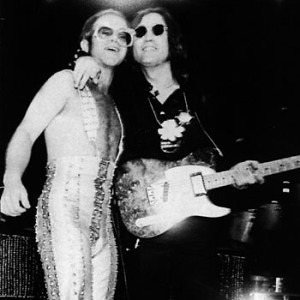
Elton John and John Lennon “Getting Thru the Night” at MSG, 1974.
“Whatever Gets You thru the Night” was recorded with Elton John during the latter part of Lennon’s “Lost Weekend” — you know, that time of personal misery and supposed creative bankruptcy where John somehow penned his only solo #1 hit. (Double Fantasy spawned a couple more after his death; but before his death, the singles were topping out as merely respectable, not the massive, grief-inspired anthems they became.)
As everybody knows, one of the biggest shifts in rock culture in the post-Beatle period was the subversion of gender. Of course this glam freedom was only extended to men — while it suddenly became OK for Marc Bolan to wear eyeliner or for Bowie to tell Melody Maker he was “gay or at least bisexual” (Jan. 1972), rock’s women were not allowed to subvert in the other direction. (They probably still aren’t, but that’s a different post.) My point is, in 1974, it was certainly possible to be a bisexual rockstar, and be almost public about it. Elton came out in 1976 (via Rolling Stone), but here’s how he characterized that interview in 2012: “I’ve been waiting for people to ask me this,” he recalled saying to the journalist in 1976. “It’s not exactly a secret. I live with my manager. I’m openly gay outside. I don’t have a girlfriend. And nobody’s ever actually out — I just thought it was common knowledge.”
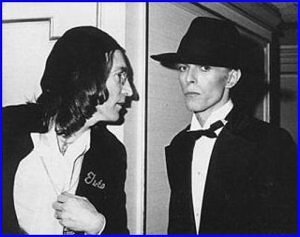
John and David at the Carter Inauguration, 1976.
Rock’s Glam Men
John didn’t have to be bisexual to become close friends with Elton (by all visible signs his closest friend during the Dakota period) or record with Bowie; both Elton and Bowie were huge talents and, in 1974, hot as a two-dollar pistol. And the collaborations were mutually superb — Elton’s “Lucy in the Sky” was a #1 hit; so was “Whatever Gets You thru the Night”; so was Bowie’s “Fame.” But what occurs to me this morning is that, however it would be categorized on the Kinsey Scale, Elton’s, Bowie’s and Lennon’s sexuality was probably a lot closer to each other’s than it would be to yours or mine. (OK, I’ll speak for myself.)
Rockstars live in a superheated world drenched with so much sexual energy and access, it seems to be actually hazardous for them — certainly it’s part of why drugs, especially depressants, seem to be endemic. In fact, a friend of mine has mentioned becoming a counselor specifically for popular musicians, to help them move through this stuff positively. This week, I read that Paul estimated he slept with “500-600” women during his Beatle years; he must’ve learned an awful lot about people as a result, not all of it good. Even in the best of circumstances, this kind of erotic life must be exciting and overwhelming in equal measure, and probably ultimately pretty deadening — imagine a rechargeable battery that’s worn out.
In that world, one’s own appetites must feel very present; there’s no avoiding what you want, because everything’s always on offer. On the other hand, there’s a level of risk that we normal folks don’t have: not just paternity suits, but also the weirdly vampiric sexuality often found in the circle around the rich and famous, something so strong that one can sense it even from the outside. (At Warhol’s “Factory” for example.) The Beatles did a very good job at covering up that part of their story; the Stones cared less to hide; then you get frankly Dionysian characters like Jim Morrison, where dark sexuality is as big a part as the music. By the ’70s, both the darkness (mudshark) and the light (greater openness) were plain to see.
So in this world, with this collaborator, at this precise time in rock history, John sings…
“Whatever gets you through the night ‘salright, ‘salright
It’s your money or life ‘salright, ‘salright
Don’t need a sword to cut through flowers oh no, oh no
Whatever gets you through your life ‘salright, ‘salright
Do it wrong or do it right ‘salright, ‘salright
Don’t need a watch to waste your time oh no, oh no
Hold me darlin’ come on listen to me
I won’t do you no harm
Trust me darlin’ come on listen to me, come on listen to me
Come on listen, listen
Whatever gets you to the light ‘salright, ‘salright
Out the blue or out of sight ‘salright, ‘salright
Don’t need a gun to blow your mind oh no, oh no
Hold me darlin’ come on listen to me
I won’t do you no harm
Trust me darlin’ come on listen to me, come on listen to me
Come on listen, listen…”
Here’s the original video of that joyous song. John stalking around being groovy in that old groovy world. Watching this, I can’t help but think: “Some ‘Lost Weekend’…”

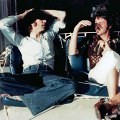
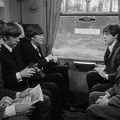


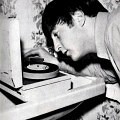
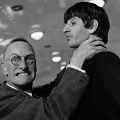
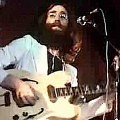


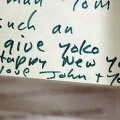

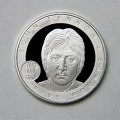
The song could well have been triggered by sleeping with a man or men during that time. It’s an interesting thought. I think artists are often right not to discuss where a song came from, since the important thing is how a work impacts any given listener. Comments made by artists about what a song is “about,” are helpful if they enlarge or enrich one’s experience of a song and unhelpful if they shrink that experience–though it’s the listener’s decision whether he or she will allow one’s experience to be impoverished. A song or poem or anything is “about” as many things as there are perceivers of it. A good writer can take a specific incident or subject and universalize so it resonates with millions, which–I’m guessing you’d agree, Michael–is what Lennon did with “Whatever,” …whatever directly inspired him to write it.
I’d do more than agree, @Chris; I’d say that’s what writing is for. We all go around living our own lives, in our own circumstances. What a blessing it is to resonate with others, what a relief!
I have never seen this video before. Adorable. He looks so happy and sexy. Ready for whatever happens…:) Hey, did Paul really say he slept with so many women? I always thought someone else informed it out of joke. But if he said it…he was kidding.
You might like this one too, Virginia. http://youtu.be/Ho1yJwvWCrw
Thank you for the link, Rob. I wonder who made de drawings. Looks like John Lennon’s! Sure I like it but somehow I prefer the one on this page because it’s real john! And he looks so happy and charming!
It seems to me that this song is a direct follow-up to How Do You Sleep? and McCartney’s response (“quite well, thank you”/Some People Never Know/Dear Friend). Toss in a few call backs to Oh! Darling and you’ve got a very typical example of Lennon’s version of being conciliatory. (“Here, have this crumb, this illusion, this stroke…”)
I hadn’t considered the possibility that Lennon could be addressing himself here. Like Two of Us and How Do You Sleep?, it could have been intended for one person and took on an entirely different meaning as time went on. (A rehearsal snippet for Two of Us includes Lennon and McCartney musing on the narrative connections between their songs, esp. Oh! Darling)
I don’t know this Paul’s song called “Quite Well, Thank you”. I read once planed to write it but gave up. So did he really compose it? I listened to this rehearsal snippet for Two of Us. Precious, very precious. Hey, where is mgerber937 comment? I got part of it on my e-mail as it it was here, but I can’t find it. I really would like to read it.
Which comment do you mean, @Virginia?
This one; “Recently we’ve been discussing the gargantuan “Time Lapse Photography” comment thread, which discusses Beatle sexuality, and specifically the erotic tension between John and Paul. It’s clear that some existed; whether or not it was acted upon is a matter of endless fan speculation (hello Johnheartpaul! Thanks for the traffic!) but ultimately between those two men […]”. It’s yours. But I read it on my e-mail box.
Virginia, here’s the comment thread. Start reading now, and you’ll be finished in about three days! 🙂
Thank you. Yes, so many things to read. And those pictures…seems like a message to Paul. Really seems. There is only one big difference. The ones with Paul are much better and more beautiful. 🙂
Well, @Virginia, few photographers can match David Bailey in his 60s prime; that session with John and Paul is really phenomenal.
I always thought “Whatever Gets You Thru the Night” was a kinder, gentler re-write of “How Do You Sleep?” Get it? LOL… “Trust me darlin’, c’mon listen to me. I won’t do you no harm” continues the theme that began in 1969. “It’s your money or your life” – during the making of Band on the Run, which preceded this song, Paul had been robbed at knifepoint or something on the streets of Lagos, with the mugger running off with his studio tapes.
Also, is it just me or did Saturday Night Live completely lift the intro of this song for theirs?